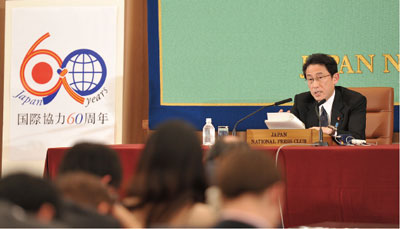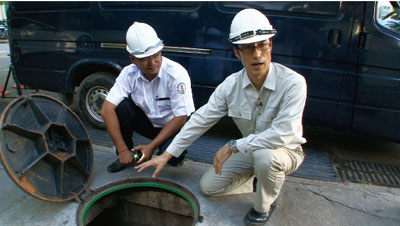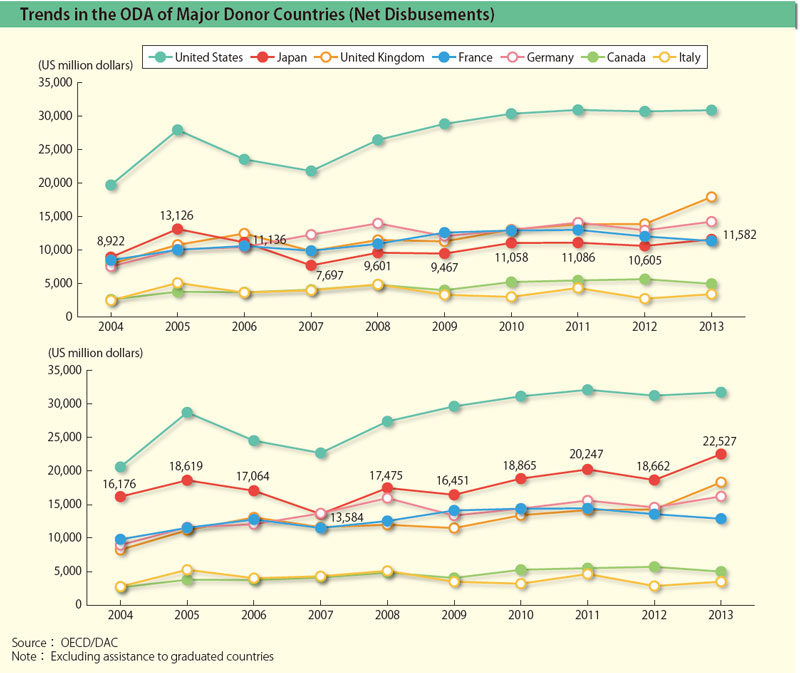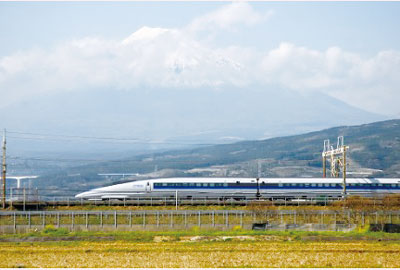Diplomatic Bluebook 2015
Chapter 3
Japan’s Foreign Policy to Promote National and Worldwide Interests
1.Official Development Assistance (ODA)
(1) Review of ODA Charter and the Current Status of ODA
A. Review of ODA Charter
Japan’s ODA Charter was revised for the first time in 12 years in February 2015 and a new “Development Cooperation Charter” was approved by the Cabinet. In this process, the Government of Japan took into consideration various public opinions, including those expressed at public hearings held throughout the country, as well as views from NGOs, the business community, and academic society.
Following the announcement of Foreign Minister, Fumio Kishida about the review of the Charter in March 2014, an Advisory Panel on ODA Review chaired by Professor Emeritus Taizo Yakushiji of Keio University was set up and the panel submitted its report in June. At the end of October, a draft of a new Charter based on the report was released and finally approved after public hearings held throughout Japan.
The New first Charter presents Japan’s outlook on the current situations of the international community. Japan’ needs to formulate its ODA policy by taking into account various factors that are developing in a new international environment: for instance, emerging issues and growing risks emerging along with the rapid globalization, diversified developing countries, complex development challenges in the multi-polarized world, newly developed countries with increasing presence as donor countries in development cooperation and the injection of private funds, which amount to about 2.5 times that of ODA, into developing countries.
 ODA Policy Speech by Foreign Minister Kishida “An Evolving ODA: For the World’s Future and Japan’s Future” (March 28, Tokyo)
ODA Policy Speech by Foreign Minister Kishida “An Evolving ODA: For the World’s Future and Japan’s Future” (March 28, Tokyo)
With this recognition, in the review of 2015, the name of the charter has been changed to the Development Cooperation Charter. This reflects Japan’s view of seeking mutually beneficial cooperation in equal partnerships, going beyond the vertical relationship between Japan and developing countries through the provision of unilateral “assistance” from the former to the latter. The new title straightforwardly expresses Japan’s future stance to strengthen collaboration with various activities through not only ODA, but also private funds, and to expand the scope of cooperation through identification of targets and issues.
Then, based on the philosophy that has been formed over the 60 years of Japan’s ODA history, the New Charter designates the following three basic policies to be pursued in the future: (a) contributing to peace and prosperity through cooperation for non-military purposes, (b) promoting human security, and (c) cooperation aimed at self-reliant development through assistance for self-help efforts as well as dialogue and collaboration based on Japan’s experience and expertise.
In line with these basic policies, three priorities are identified in the process of international cooperation: (a) “quality growth” and poverty eradication through it, (b) sharing universal values and realizing a peaceful and secure society, and (c) building a sustainable and resilient international community through efforts to address global challenges.
As implementation principles, the charter lists principles for effective and efficient development cooperation including through more strategic approaches and principles for appropriate development cooperation, including avoidance of any use of development cooperation for military purposes or for aggravation of international conflicts, and promotion of women’s participation.
As for implementing agencies, the charter specifies collaboration with diverse bodies, such as private companies, including small and medium enterprises (SMEs), local governments, universities/research institutions, international organizations, and NGOs.
In the future, Japan will implement more strategic and effective development cooperation under the new charter.
B. Priority Policy for International Cooperation
The significance of ODA is becoming even more profound as one of the most important diplomatic means for promoting the principle of “Proactive Contribution to Peace” in dealing with changing circumstances surrounding Japan. Under the following three pillars listed in the FY2014 Priority Policy for International Cooperation, Japan has been utilizing ODA strategically and effectively.
(a) ODA to Create an International Environment Favorable to Japan
Japan will seek to realize stable development of countries which share universal values, such as freedom, democracy, and the rule of law, and strengthen relations with these countries. Japan will support the development of legal systems and stabilization based on these universal values. Also, Japan will actively contribute to peace and the stability of the international community through ODA in areas such as peacebuilding, counterterrorism, enhancing maritime law enforcement capabilities, and ensuring safety in sea lanes.
(b) ODA to Support Emerging/Developing Countries in Growing Together with Japan
In coordination with policies such as the “Japan Revitalization Strategy,” Japan will provide ODA strategically to contribute to the development of emerging/developing countries as well as to create synergy with the vitality of these countries. While making use of the advanced technologies and expertise of Japanese companies, including SMEs and local governments, Japan will seek to spread Japanese systems and methods and provide assistance, contributing to the improvement of business environment.
 Technical Cooperation Project to Cambodia in collaboration with Kitakyushu City
Technical Cooperation Project to Cambodia in collaboration with Kitakyushu City
(c) ODA to Promote Human Security and Strengthen Trust in Japan
In line with the fundamental principle of human security, which pays attention to each individual as a person and seeks to protect and empower the person, Japan will provide assistance to realize poverty reduction and inclusive growth, as well as to achieve the Millennium Development Goals (MDGs). Especially in the field of disaster risk reduction/post-disaster reconstruction, promotion of universal health coverage (UHC) based on Japan’s Strategy on Global Health Diplomacy, and women’s empowerment, Japan will implement ODA in unique ways that will strengthen trust in Japan and an enhancement of its international presence.
(2) Japan’s ODA Performance and Approaches to Major Regions
A. Japan’s ODA Performance
Japan’s ODA performance in 2013 in terms of total disbursements was about 22.53 billion US dollars, up 20.7% from the previous year. Japan ranks second among OECD/DAC member states, following the United States. In terms of net disbursements, which are generally used for international comparison, the amount is 11.58 billion US dollars, up 9.2% from the previous year, ranking 4th after the US, the UK and Germany. The ODA/GNI ratio based on net disbursements was 0.23%, ranking 18th among 28 member states of the DAC.
B. Approaches to Major Regions
(a) Asia
The East Asian region has a close relationship with Japan in all aspects including politics, economy, and culture and this has great significance for the safety and prosperity of Japan itself. Japan focuses its assistance on the East Asian region and approximately 50% of the total bilateral ODA of Japan went to this region in 2013.
As for ASEAN countries, Japan announced at the ASEAN-Japan Commemorative Summit Meeting in December 2013 that it would provide ODA of 2 trillion yen over 5 years to support development of infrastructure and human resources, aiming for enhanced connectivity and a narrowing of the development gap toward ASEAN integration in 2015. For the Mekong region, the Tokyo Strategy 2012 for Mekong-Japan Cooperation adopted at the Mekong-Japan Summit Meeting in 2012 has been steadily implemented. As of November 2014, Japan had already committed over 500 billion yen, while the original goal was 600 billion yen over three years from FY2013. As part of this, Japan’s assistance for Myanmar took full-fledged shape in supporting reform efforts in a wide range of fields toward democratization, national reconciliation, and sustainable development. A focus was placed on priority areas such as welfare improvement/poverty reduction, including support for minority tribes, human resources development/institutional development, and infrastructure development for sustainable growth.
Also, to appropriately respond to substantial demand for infrastructure around the world, including in Asia, Prime Minister Shinzo Abe, taking opportunities such as the APEC Summit Meeting of November 2014, the Japan-ASEAN Summit Meeting and the G20 Summit Meeting, announced a policy of enhancing assistance for quality infrastructure development toward achieving sustainable quality growth. This is intended to promote an “investment in people” that would contribute to benefits for each individual through job creation and improved access to social services, disaster preparation, and harmony with environment and capacity building. This will be achieved through an approach focusing on effective financial mobilization involving the private sector, consideration for environment and society, and capacity building/human resources development.
The economy has developed in South Asia, but many problems such as undeveloped infrastructures and poverty still remain unsolved. While also keeping in mind improving investment environment for Japanese companies and human security, Japan provides a range of assistance through ODA to assist the region in overcoming these challenges. Japan pledged new yen loans to India totaling 200 billion yen at the Japan-India summit meeting in January 2014. Furthermore, at the summit meeting with India in September, Japan expressed its intention to realize 3.5 trillion yen of public and private investment and financing from Japan, including ODA, to India over the next five years to support its development. For Bangladesh, at the summit talks in May and September, Japan expressed its commitment to delivering up to 600 billion yen of assistance over the course of four to five years, and both leaders confirmed their intention to promote cooperation under the concept of the Bay of Bengal Industrial Growth Belt (BIG-B). For Sri Lanka, Japan expressed its willingness during the Japan-Sri Lanka summit meeting in September to extend its support to Sri Lanka’s efforts toward developing itself into an upper middle income country, the enhancement of maritime law enforcement capabilities, and the realization of national reconciliation.

(b) Latin America and the Caribbean
Latin America and the Caribbean countries and Japan have a long-standing friendly relationship and historically close ties, with around 1.8 million Japanese descendants (“Nikkei”) living in those countries. The region is a huge supply center for resources and food and, at the same time, is a prospective emerging market, with its Gross Regional Product reaching almost 6 trillion US dollars under the stable growth of recent years.
On the other hand, many countries in this region still face challenges such as income disparities and poverty in rural or mountainous areas. Moreover, as these countries are highly vulnerable to natural disasters, efforts in the field of environment, climate change, and disaster risk reduction are also important. Japan has been providing various forms of assistance to support the efforts of Latin America and the Caribbean countries to address these issues, considering the particularity of each country.
From the end of July to early August 2014, Prime Minister Abe visited Mexico, Trinidad and Tobago, Columbia, Chile, and Brazil, and announced concrete assistance policies in each country. In particular, in Trinidad and Tobago, the Prime Minister announced that, taking into account the vulnerabilities particular to small island states of CARICOM Member States, Japan recognized the importance of assisting them from perspectives other than those based on per-capita income, and would conduct field surveys on future cooperation. In Brazil, the Prime Minister announced his intention to take various measures to strengthen the relationship between Japan and the Japanese descendants (“Nikkei”) community, stating that the presence of ethnic Japanese there has raised trust in Japanese people as a whole in Latin America and the Caribbean.
(c) Middle East
Securing peace and stability in Middle Eastern/Northern African regions is crucial to the world’s stability. Considering its energy security, Japan proactively provides support for this region. In light of the serious humanitarian crisis in Syria with 7.6 million internally displaced persons and over 3.3 million refugees outside Syria, Japan has delivered humanitarian aid worth more than 400 million US dollars to Syria and neighboring countries. In implementing support, consideration in line with the principles of human security has been made in particular to those most vulnerable, such as women and children, in areas such as education, water, and health/sanitation.
As for Iraq, Japan has accomplished the total amount of 5 billion US dollars of assistance for Iraq’s reconstruction by May 2012 that was pledged at the International Donors’ Meeting for Reconstruction in Iraq in 2003. By FY2013, Japan had accepted approximately 6,000 Iraqi trainees through JICA’s technical cooperation. At present, Japan provides support for the realization of the self-reliant development of the country.
Furthermore, Japan and the international community are providing support to promoting Afghanistan’s self-reliance and the stability of the region in order to prevent Afghanistan from stepping back to a hotbed of terrorism. Japan provided a total of about 5.5 billion US dollars from 2001 to December 2014, in development assistance mainly in the three areas of: improvement of security capabilities, reintegration of anti-government militias into society, and support for sustainable development.
(d) Africa
Sub-Saharan Africa is still facing serious poverty. On the other hand, the region is endowed with rich natural resources and tourism potential. It recorded an average economic growth of 5.8% during the period from 2001 to 2010 against the backdrop of population growth. This region draws increasing attention as a prospective import partner, market, and production center.
Japan is now committed to the steady implementation of approximately 3.2 trillion yen in public-private initiatives, including approximately 1.4 trillion yen in ODA, which was pledged at the Fifth Tokyo International Conference on African Development (TICAD V). Japan reported that it already delivered approximately 340 billion yen of assistance in ODA and approximately 200 billion yen in other forms in the past year at the First TICAD V Ministerial Meeting held in Cameroon in May 2014. Also, at the Second Japan-African Regional Economic Communities (RECs) Summit Roundtable held in New York in September, Japan reported that it was already implementing the equivalent of roughly 230 billion yen in projects out of the public fund assistance worth 650 billion yen for infrastructure development over five years. Japan will continue making efforts for further enhancing the Japan-Africa partnership through TICAD process, including through the follow-up of TICAD V.
Furthermore, Japan has been providing seamless assistance since the initial stage of the outbreak of Ebola virus disease in West Africa. Through bilateral assistance and via international organizations, Japan has implemented emergency humanitarian aid of over 50 million US dollars, including the provision of Personal Protective Equipment (PPE), as well as the dispatch of experts through WHO. In addition to the above, Japan announced in November its further contribution of up to 100 million US dollars. Japan is also promoting universal health coverage (UHC) to build a healthcare system in which everyone has access to basic health and medical services. Japan will continue to contribute, based on the principle of UHC, to the medium and long-term reconstruction of health systems in West Africa.
(3) Approaches to appropriate and effective implementation of ODA
In the process of ODA implementation, it is extremely important to disclose information to the public and ensure transparency at each stage from project planning, implementation, and post-implementation evaluation and the follow-up so as to make the aid more effective and efficient. The following approaches are taken to that end.
A. Approaches to Appropriate Implementation of ODA
Prior to implementing survey for the formulation of a new project under grant aid, loan aid or technical cooperation, submissions must pass through Development Project Accountability Committee. This committee has been set up to exchange views on the contents of the survey between external experts and the relevant personnel of the Ministry of Foreign Affairs (MOFA)/JICA in an attempt to further increase the effectiveness and improve transparency of ODA projects.
Moreover, since ODA is founded on tax money collected from the people, fraudulent or dishonest action related to ODA projects would not only impede appropriate and effective implementation of assistance but also damage the trust of the people in ODA projects. This is absolutely not tolerated. Regrettably, cases of illegality and corruption associated with ODA occurred in 2014. In response, MOFA and JICA have decided to reinforce the information desk on illegality and strengthen measures against corporations involved in illegal actions.
B. Approaches to Effective Implementation of ODA
In order to provide effective and efficient assistance based on the issues and needs of the recipient country, Japan has formulated individual assistance policies for each country. In principle, these policies shall be developed for all the recipient countries and policies for 106 countries have been formulated as of December 2014.
Japan is making efforts to enhance its Program Approach to implement effective and concrete ODA projects tailored to specific goals by setting up a goal for the solution of specific development issues through consultation with the recipient country.
In the meantime, the introduction of a systematic numerical target into project-type grant aid from the perspective of enhancing the PDCA cycle has been selected as one of the Good Practices in project improvement by the Administrative Reform Promotion Council in June.
In the Development Cooperation Mutual Review on Japan released by DAC in July 2014, clear vision, leadership in disaster prevention and health areas, and the use of diverse schemes and efforts for triangle cooperation were highly rated. On the other hand, some issues were pointed out as requiring attention: specifically, increases in the amount of ODA, increases in internal awareness about development, and the expansion of participation.
C. Approaches toward Promotion of Information Disclosure on ODA
In order to raise the quality of ODA, it is necessary to apply the knowledge and know-how obtained from ODA evaluations to subsequent policy planning and project implementation. MOFA carries out evaluations through external experts and uses and shares the evaluation results among the relevant parties. Also, from the viewpoint of improving transparency of JICA’s projects, the current status and achievements of projects are made available on the “Visible ODA” section of JICA’s website. As of the end of December 2014, a total of 2,960 projects are listed on this site.
The understanding and support of the people of Japan is essential for the implementation of ODA and, therefore, efforts are made for effective communication and the promotion of their understanding. The year 2014 marked the 60th anniversary of Japan’s ODA. Taking this as an opportunity, various PR events took place aiming to reach out to a wide range of people: for example, Global Festa JAPAN 2014 held in Tokyo in October, Japan’s largest event for international cooperation and the Symposium Commemorating the 60th Anniversary of Japan’s International Cooperation held in Tokyo in November. According to an opinion poll on diplomacy taken in 2014, the number of respondents stating that international cooperation must be actively promoted increased from the previous poll taken in 2011. Japan will continue its efforts in the active provision of information.
1. The 60th Anniversary of Japan’s ODA-paying it Forward to the World
The year is 1954. Having just put the war behind it, Japan took its first step toward international cooperation by becoming a member of the Colombo Plan1. In the 60 years after that, under the three features, namely themes of support for self-improvement efforts, sustainable economic growth, and human security, Japan has provided assistance of approximately 42 trillion yen to about 190 countries and regions, dispatched about 136,000 experts and 47,000 volunteers, and received about 540,000 trainees.
 Tokaido Shinkansen running against a background formed by Mt. Fuji
Tokaido Shinkansen running against a background formed by Mt. Fuji
On the other hand, it must not be forgotten that Japan, which has become a major donor today, had also previously benefited from the support of the international community, including the World Bank (WB). The infrastructure that underpins our everyday lives, such as the Tomei Meishin Expressway, Kurobe Dam, and the Tokaido Shinkansen which celebrated its 50th anniversary in 2014, were built with loans procured from around the world. Japan had only repaid all of these loans fully recently, in 1990.
From ancient times, the expression “pay it forward” has already existed in Japanese society. Based on this concept, when one receives a favor from someone, he or she “pays it forward” to a third person rather than return it to the first, thereby benefitting the whole society. The assistance that Japan continues to provide to other countries today could be described as putting into practice the concept of “paying it forward.”
Japan’s sincere attitude toward contributing to the international community has, in part, made it the most trusted country in a public opinion survey conducted in March 2014 in ASEAN countries. Close to 90% of the respondents also felt that Japan’s economic and technological cooperation has contributed to the development of their own countries. Japan will continue to harness ODA as an important instrument of diplomacy.
2. Japan’s International Cooperation found in every corner of the World
 Embankments, built with Japan ODA support, protected citizens of Male from the tsunami (Source: Maki Tsukamoto, JICA)
Embankments, built with Japan ODA support, protected citizens of Male from the tsunami (Source: Maki Tsukamoto, JICA)
The Republic of Maldives, which is an island nation floating in the Indian Ocean, was struck by a tsunami caused by the earthquake off the coast of Sumatra in 2004. However, the damage incurred in the tsunami was minimal owing to the embankments which had been built with assistance from Japan. Furthermore, Japan also provided support promptly for projects to bring about the recovery of the fishing industry, agricultural industry, and local administration, and assisted in the reconstruction of infrastructure such as ports and sewerage systems.
In the aftermath of the Great East Japan Earthquake that struck in 2011, Japan received assistance from more than 160 countries and regions across the globe, including many developing countries. The Maldives also donated about 700,000 cans of tuna, while 20,000 citizens in the capital of Male participated in a walking event in solidarity with the afflicted peoples. A television program was also broadcast for 24 hours to raise relief funds. These and other forms of support and solidarity were extended to Japan, reaffirming the warm ties between the two countries.
- 1 The Colombo Plan is an international institution that launched activities in 1951 to provide support for the economic development of countries in the Asia Pacific region. As a member of the Initiative, Japan began engaging in technical cooperation activities in 1955 by receiving trainees and dispatching experts.

